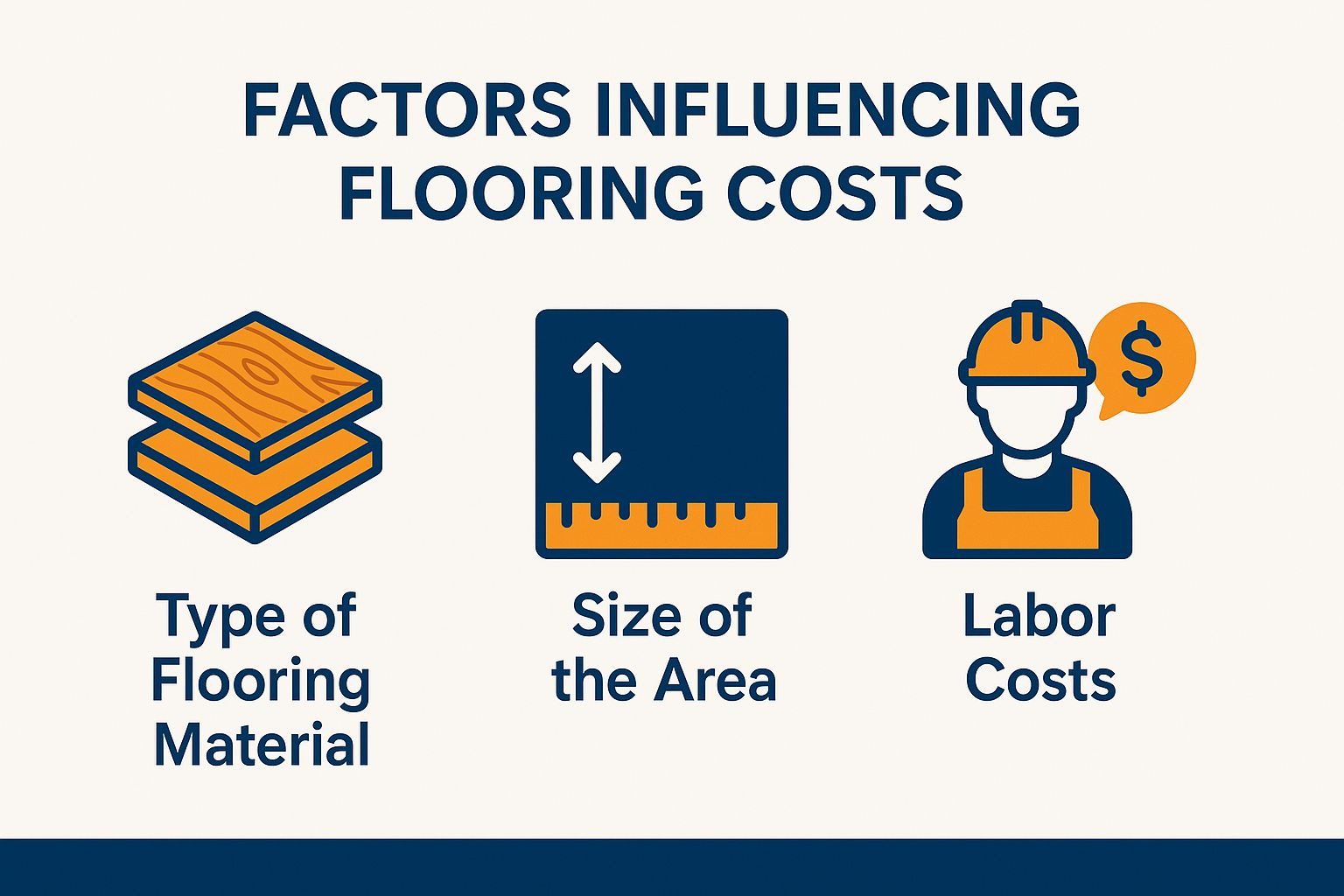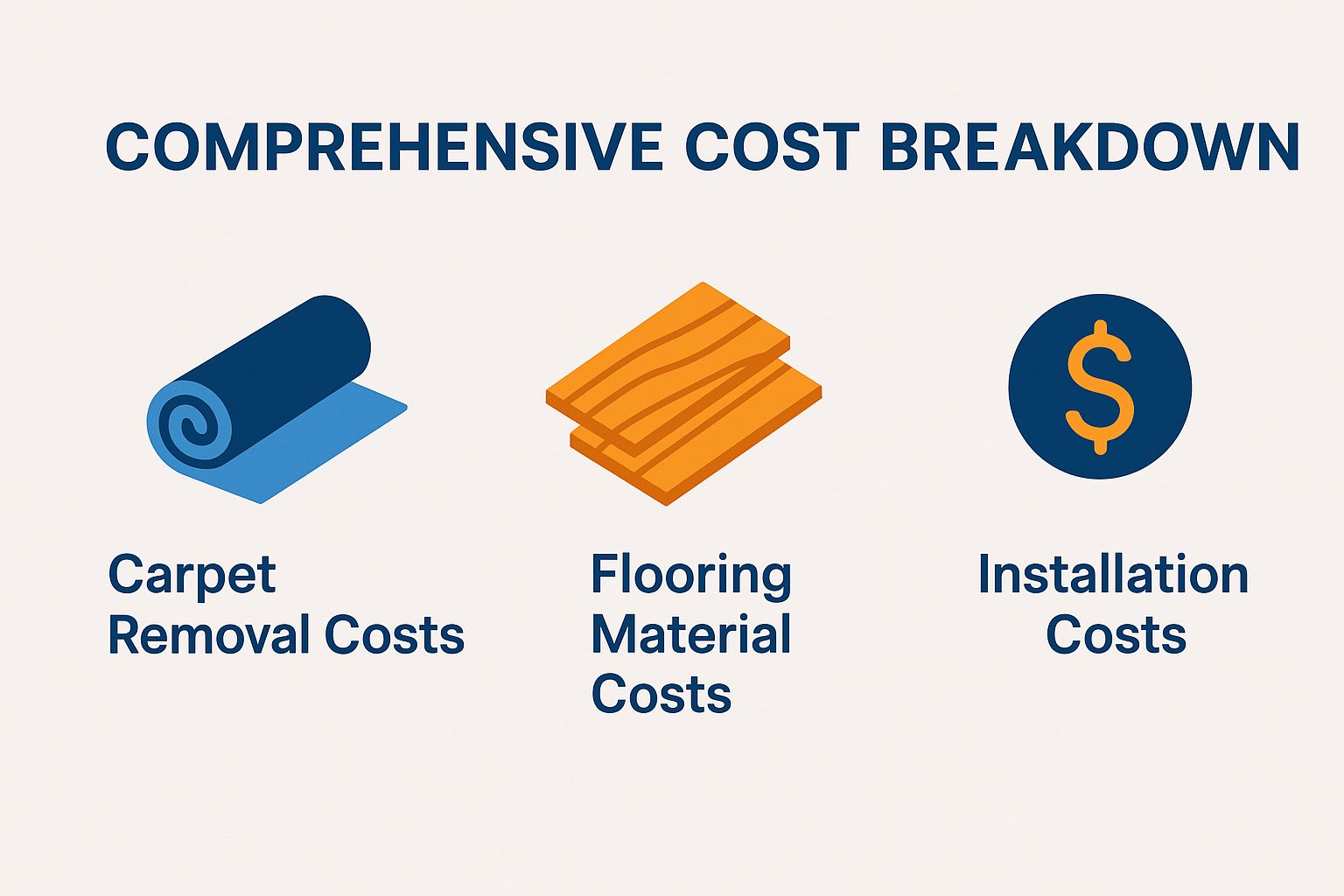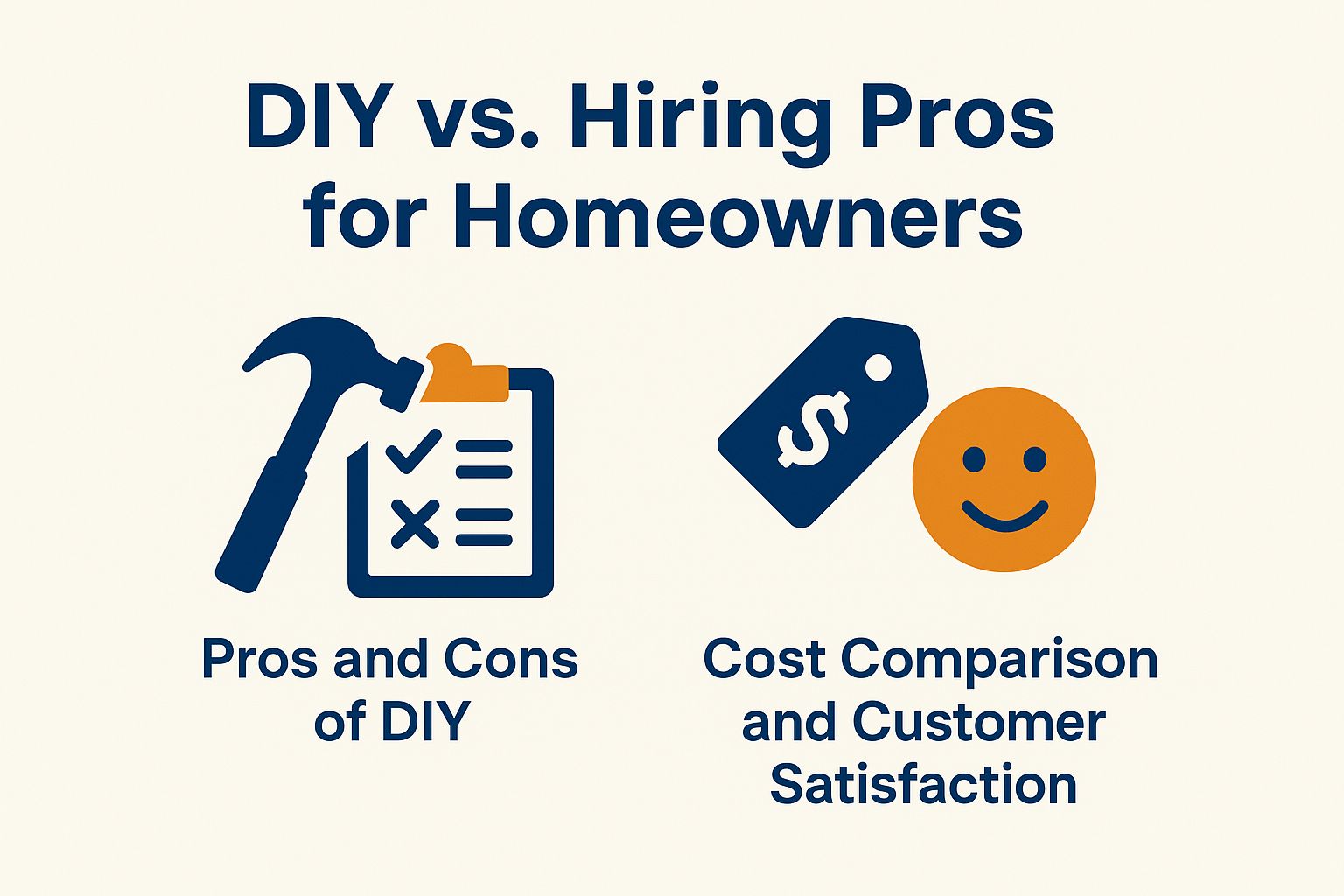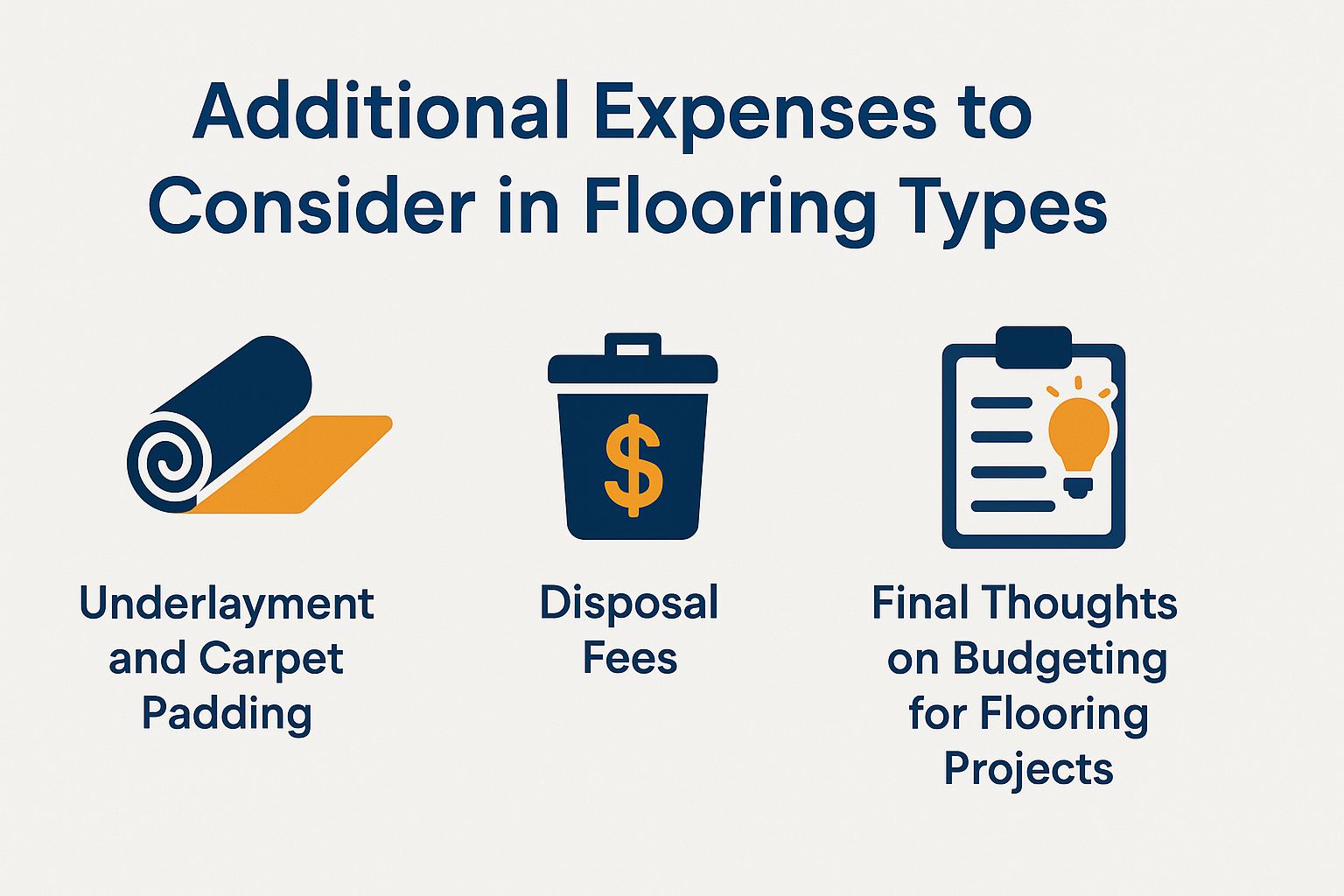
Are you considering a home makeover? Understanding the costs of carpet removal and flooring installation, including carpet removal labor and installation costs, is crucial for budgeting your home improvement project. With the national average cost varying by material-like hardwood flooring, vinyl flooring, or carpet-knowing the cost per sq. ft. can help you make informed decisions about flooring options. In this article, we’ll break down what influences pricing, including contractor pricing and repair costs, and provide insights into how to efficiently transition from carpet to stylish new flooring.
Many factors affect the overall cost of flooring projects, including material choice and labor expenses.
Overview of Carpet Removal and Flooring Installation
Homeowners need to understand how to remove carpet and install new flooring. This knowledge helps in making informed renovation decisions.
- Begin by removing all furniture from the room to create a safe and unobstructed workspace, which is a critical step in the furniture removal process.
- Next, utilize a utility knife to cut the carpet into manageable strips, rolling them up as you proceed to facilitate removal, an important part of the carpet replacement process.
- Carefully remove any tack strips using a pry bar, ensuring that the subfloor remains undamaged during this process, which is crucial for maintaining flooring durability.
- After the carpet has been completely removed, inspect the subfloor for any uneven surfaces, which can be addressed with a self-leveling compound, especially important in areas like the basement.
- For the flooring installation, lay down an underlayment for moisture control, and then position the selected flooring-whether it be laminate, hardwood, or tile-according to the manufacturer’s guidelines, ensuring that each piece is fitted snugly for a professional finish.
Factors Influencing Flooring Costs
A variety of factors influence the overall cost of flooring projects, affecting aspects ranging from material selection to labor expenses.

Type of Flooring Material and Flooring Types
Flooring material selection greatly influences costs. Hardwood ranges from $5 to $10 per square foot, while vinyl ranges from $2 to $7.
Tile is another widely favored alternative, generally costing between $1 and $8 per square foot in the current flooring industry. Hardwood usually needs a pro for installation. Vinyl can be a DIY project.
Regarding flooring durability, hardwood lasts long but can scratch. Vinyl is water-resistant, ideal for kitchens and bathrooms. Tile is durable but may crack.
Regular maintenance practices include refinishing hardwood every few years, while both vinyl and tile require periodic deep cleaning and sealing to maintain their longevity and appearance.
Size of the Area and Carpet Types
The area size affects project costs. Project costs depend on the area size. Larger spaces can lead to savings.
To measure for flooring, multiply the room’s length by its width.
For example, a room measuring 12 feet by 15 feet has an area of 180 square feet. When estimating costs, it is important to consider the price per square foot for the selected flooring material. Always add 10% for waste. For a room of 180 sq ft and $7 per sq ft, include an extra $126 for a total of $1,386.
Additionally, it is advisable to include an extra 10% for waste and errors. This results in a final estimate of $1,386, accounting for potential construction waste.
Labor Costs and Contractor Quotes
Labor costs range from $1 to $4 per square foot. These costs vary based on several factors, including removing existing flooring, needing subfloor repairs, and the type of new flooring.
Prices vary based on job complexity and local rates.
Several factors influence these costs. They include removing existing flooring, needing subfloor repairs, and the type of new flooring installed.
Removing carpet may add about $0.50 per square foot. Repairing damaged subfloors could increase costs by up to $2 per square foot.
For a precise estimate, request quotes from multiple contractors. Ensure they detail included services and any potential extra charges.
Detailed Cost Breakdown
A detailed cost breakdown helps homeowners understand the financial implications of flooring projects. This covers all stages from removal to installation.

Carpet Removal Costs and Disposal Fees
Carpet removal costs typically range from $1 to $2 per square foot. Disposal fees may vary from $50 to $150, depending on local regulations.
Carpet removal labor costs typically constitute a substantial portion of the total expense, often ranging from $60 to $100 per hour, contingent upon the complexity of the task.
Consider renting a carpet removal tool for about $25 to $50 per day instead of hiring professionals to save on costs.
Explore recycling options like the Carpet America Recovery Effort. Some facilities accept old carpet for free, which can reduce disposal fees. By combining do-it-yourself labor with recycling initiatives, it is possible to significantly decrease the overall expenditure.
Flooring Material Costs and Pricing Databases
Flooring material costs vary widely. Hardwood flooring can range from $5 to $15 per square foot, while carpet may be priced as low as $1 per square foot, according to various pricing databases.
Vinyl flooring usually costs between $2 and $7 per square foot. Prices vary based on thickness and style. Premium options, such as luxury vinyl tiles, tend to be more expensive but provide enhanced durability.
Several factors influence these costs, including brand reputation, installation methods, and regional availability. Renowned brands, such as Mohawk, often command higher prices due to their perceived quality.
For the best value, compare samples from multiple retailers. Be on the lookout for sales, as they can greatly reduce overall costs.
Installation Costs and Cost Ranges
Installation costs, an important part of cost ranges, can range from $2 to $4 per square foot, depending on the complexity of the project and the type of flooring selected. Factors influencing these costs include regional labor rates and any additional work that may be required, such as subfloor preparation or adhesive application for specific materials.
For example, selecting luxury vinyl tiles may necessitate a level subfloor to ensure proper installation, which could increase overall costs. Conversely, opting for simpler flooring options like laminate may allow for a floating installation, potentially reducing labor expenses.
To obtain a precise estimate, it is advisable to solicit quotes from multiple contractors, ensuring that they provide detailed information regarding included services and any potential additional charges.
DIY or Hiring Professionals: What Homeowners Should Consider
The choice between undertaking a do-it-yourself approach and engaging professional services can significantly influence both budgetary constraints and the overall quality of the project for homeowners.
This decision is crucial for homeowners.

Pros and Cons of DIY Carpet Installation
A DIY approach to carpet installation can save you money. However, it carries the risk of costly errors if not done carefully.
The advantages of DIY flooring include substantial financial savings, with materials generally priced between $1 and $5 per square foot, in contrast to professional installation costs that can exceed $10 per square foot. Additionally, the personal fulfillment derived from successfully completing a project can be quite rewarding.
Conversely, the disadvantages include a significant time investment. Installing flooring can take 20 hours or more for an average-sized room. There are also inherent risks, such as inaccurate measurements that can lead to extra costs.
For example, an acquaintance who attempted to install vinyl planks found that miscalculations and damaged materials resulted in expenditures that were double the initial estimate.
Comparing Costs and Customer Satisfaction
A DIY approach may seem cheaper at first. However, hiring professionals usually leads to better quality and faster results.
For example, a DIY kitchen installation costs around $1,500 for materials and tools. Hiring a professional can range from $3,000 to $5,000.
Many professionals provide warranties and have extensive experience. This reduces the risk of costly mistakes.
A particular case study illustrated a DIY project that exceeded its budget by 30% due to unforeseen complications, while a professional’s expertise allowed for the project to be completed on schedule and within the quoted budget, ultimately proving to be more economical over time.
Other Expenses to Consider for Flooring
Besides primary costs, several additional expenses can impact your flooring budget. Homeowners often overlook carpet padding and glue-down carpet costs.

Underlayment and Carpet Padding
Quality underlayment and carpet padding range from $0.50 to $2 per square foot. They significantly affect both comfort and durability. Investing in high-quality padding reduces wear and improves comfort. This leads to lower long-term maintenance costs and enhances your flooring experience. Selecting the appropriate underlayment is essential for achieving optimal flooring performance.
For example, foam underlay is particularly effective for soundproofing and moisture control, whereas cork provides outstanding thermal insulation and sustainability. A mid-range option such as rubber padding strikes a balance between durability and comfort, rendering it suitable for areas with heavy foot traffic, including basement carpet installations.
Investing in high-quality padding reduces wear on flooring and improves comfort. This leads to lower long-term maintenance costs. Making informed decisions regarding these materials can greatly enhance the flooring experience.
Disposal Fees
Disposal fees for flooring materials can add $50 to $150 to project costs. This varies based on local regulations and the material type. To mitigate these expenses, it is advisable to explore eco-friendly disposal options, such as contacting local recycling centers that accept flooring remnants. For instance, organizations like PlanetReuse facilitate the reuse of materials, which could result in significant savings on disposal fees.
Additionally, some municipalities may provide curbside pickup for certain materials; therefore, it is prudent to consult with local waste management services. Research local disposal regulations and available resources beforehand. This knowledge helps manage costs effectively.
Investigating donation opportunities for reusable flooring can also lessen costs while supporting sustainability initiatives. It is essential to conduct thorough research in advance to understand local disposal regulations and available resources.
Final Thoughts on Budgeting for Flooring Projects
A well-planned budget for flooring installation enhances your home’s appeal. It also ensures satisfaction with your financial investment, reflecting current flooring trends.
To formulate an effective budget, one should begin by determining the total expected expenditure, which includes costs for materials, labor, and potential unforeseen expenses. It is advisable to research various flooring options-such as hardwood, laminate, and tile-along with their respective pricing structures.
Utilizing resources like HomeAdvisor can provide valuable quotes from local contractors, thereby aiding in the refinement of labor costs.
Furthermore, it is prudent to allocate a contingency fund of 10-15% for unexpected expenses, such as subfloor repairs. Consulting with flooring specialists can provide additional clarity regarding options and ensure that the budget is aligned with both aesthetic aspirations and maintenance preferences.
Frequently Asked Questions
How much does it cost to rip up carpet and install new flooring materials?
The cost of ripping up carpet and installing flooring can vary greatly depending on the type of flooring you choose and the size of the area you want to cover. Typically, expect to spend $1,500 to $3,500 for this project.
What Factors Impact Carpet Removal and Flooring Installation Costs?
The cost of this project can be affected by several factors, including flooring type and quality, area size, prep work, and labor costs of the professionals you hire.
Can I save money by doing the work myself?
This project can be tough and time-consuming. It’s often better to hire professionals. However, if you have installation experience and the right tools, you might save money by doing it yourself.
What type of flooring is the most cost-effective to install?
Laminate and vinyl flooring are typically the most cost-effective options for this type of project. These options are durable, easy to install, and available in various styles to fit any budget.
Will I need to hire a separate contractor to remove the old carpet?
Most flooring installation companies also offer carpet removal services. However, if you choose to hire a separate contractor, it may increase the overall project cost.
Are there any additional costs I should be aware of?
In addition to the cost of the flooring and installation, you may also need to budget for subfloor repairs, moving fees, and disposal of old materials. Consider carpet wear and allergies when budgeting.